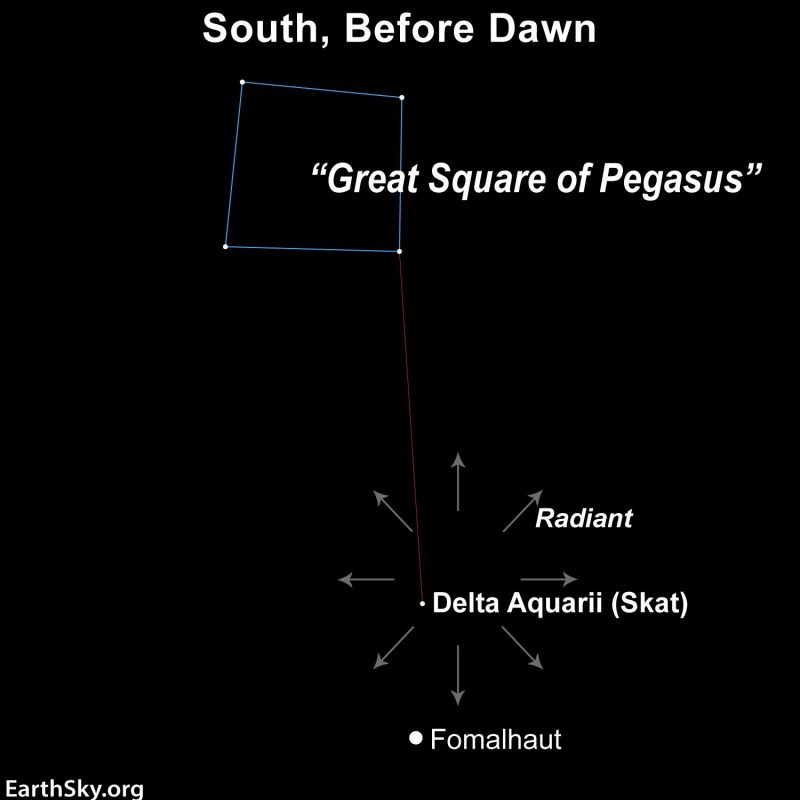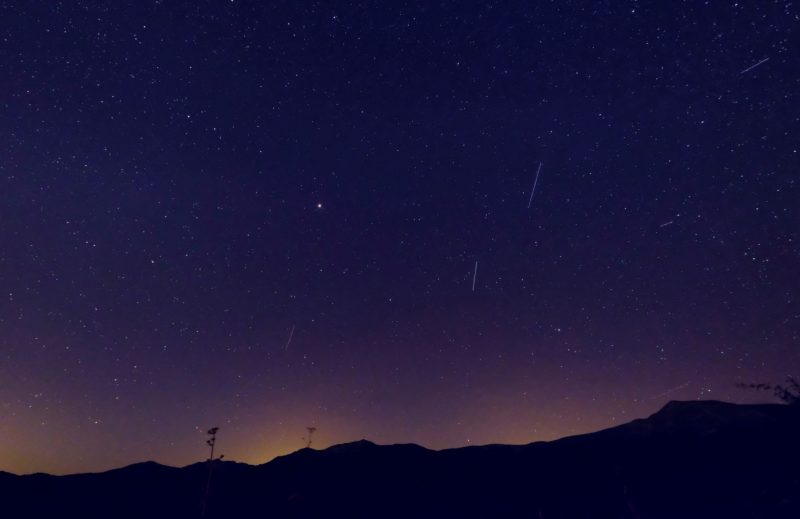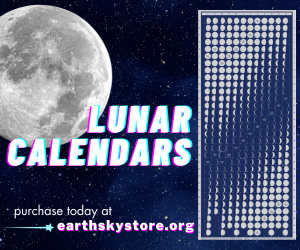
Every year, 2 meteor showers – the famous Perseids and the lesser known Delta Aquariids – converge in late summer. The Delta Aquariids always peak in late July – but in 2024 – the waning gibbous and last quarter moon will light up the sky past midnight. So, the best time to watch for both Delta Aquariids and Perseidsis is before the moon rises in late July.
Predicted peak: The peak is predicted** for July 30, 2024, at 15:16 UTC. But this shower doesn’t have a noticeable peak. It rambles along steadily from late July through early August, joining forces with the August Perseids.
When to watch: Watch late July through early August, mid-evening to dawn.
Duration of shower: July 18 to August 21.
Radiant: Rises in mid-evening, highest around 2 a.m. and low in the sky by dawn. See chart below.
Nearest moon phase: In 2024, last quarter moon falls at 2:51 UTC on August 1. Take advantage of the moon-free evenings – around midnight – in late July for watching the Delta Aquariids (and the early Perseids).
Expected meteors at peak, under ideal conditions: The Delta Aquariids’ maximum hourly rate can reach 15 to 20 meteors in a dark sky with no moon. You’ll typically see plenty of Delta Aquariids mixed in with the Perseids, if you’re watching in early August.
Note: Like May’s Eta Aquariids, July’s Delta Aquariids favors the Southern Hemisphere. Skywatchers at high northern latitudes tend to discount it. But the shower can be excellent from latitudes like those in the southern U.S. Delta Aquariid meteors tend to be fainter than Perseid meteors. So a moon-free dark sky is essential. About 5% to 10% of the Delta Aquariid meteors leave persistent trains, glowing ionized gas trails that last a second or two after the meteor has passed.
Report a fireball (very bright meteor) to the American Meteor Society: it’s fun and easy!
The Delta Aquariid’s parent comet
From the late, great Don Machholz,(1952-2022), who discovered 12 comets…
The Delta Aquariid meteor shower’s parent comet comes from the 96P/Machholz Complex.
The 96P/Machholz Complex is a collection of eight meteor showers, including the Delta Aquariids, plus two comet groups (Marsden and Kracht), and at least one asteroid (2003 EH1). These meteors showers, and these comets, appear to share a common origin (although they’ve now diverged slightly in their orbits around the sun).
They are all related to the comet known as 96P/Machholz, which I discovered on May 12, 1986, from Loma Prieta Mountain in California.
At discovery, the comet was magnitude 10 and 2 degrees south of the Andromeda galaxy. I was using my 6-inch homemade binoculars for this find. Read the story of the discovery.
As a matter of fact, scientists had suspected the existence of the 96P/Machholz Complex in 2003. Finally, they fully described it in 2005, after conducting more studies.
Comet 96P/Machholz orbits the sun every 5.3 years and gets eight times closer to the sun than we are. That is, its perihelion distance is 0.12 astronomical units (AU). One AU is the distance between the Earth and the sun. So this comet comes well inside the orbit of Mercury. Over the course of 4,000 years, the comet’s orbit changes in shape and tilt, so that it leaves particles throughout the inner solar system. It gets around!
A recent study suggests that the material causing the Delta Aquariid meteor shower left the comet’s nucleus about 20,000 years ago. It’s old dust streaking across our skies.

Perseid? Or Delta Aquariid?
Perseid and Delta Aquariid meteors fly in our skies at the same time of year. How can you tell them apart? This is where the concept of a radiant point comes in handy. If you trace all the Delta Aquariid meteors backward, they appear to radiate from a certain point in front of the constellation Aquarius, which, as viewed from the Northern Hemisphere, arcs across the southern sky.
Meanwhile, the Perseids radiate from the constellation Perseus, in the northeast to high in the north between midnight and dawn as seen in Northern Hemisphere skies.
So – assuming you’re in the Northern Hemisphere, and watching around midnight or after – if you’re watching the Perseids and you see meteors coming from the northeast or north … they are Perseids. If you see them coming from the south … they are Delta Aquariids. In a particularly rich year for meteors, if you have a dark sky, you might even see them cross paths!
Consequently, it can be an awesome display.
Delta Aquariid meteor shower photos from the EarthSky community
Submit your night sky photos to EarthSky here


Bottom line: The peak of the Delta Aquariid meteor shower is late July. But the shower rambles along steadily in late July and August, intermingling with the Perseids. In 2024, watch in the moon-free evenings – around midnight – of late July to avoid moonlight.
**Predicted peak times and dates for 2024 meteor showers are from the American Meteor Society. Note that meteor shower peak times can vary.
Everything you need to know: Perseid meteor shower











